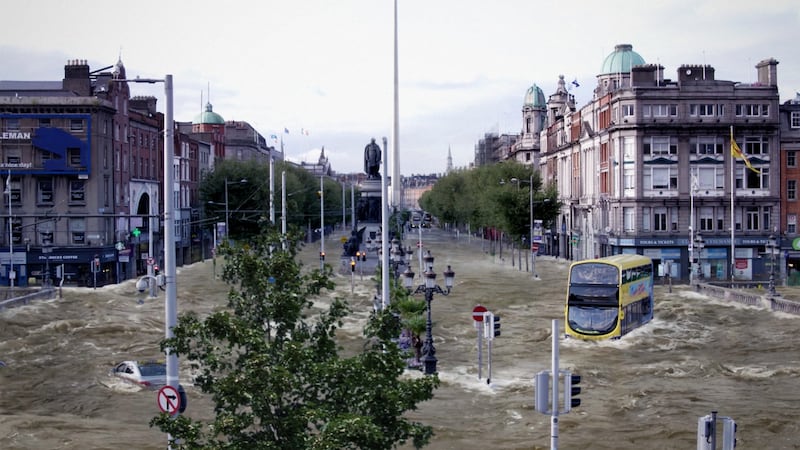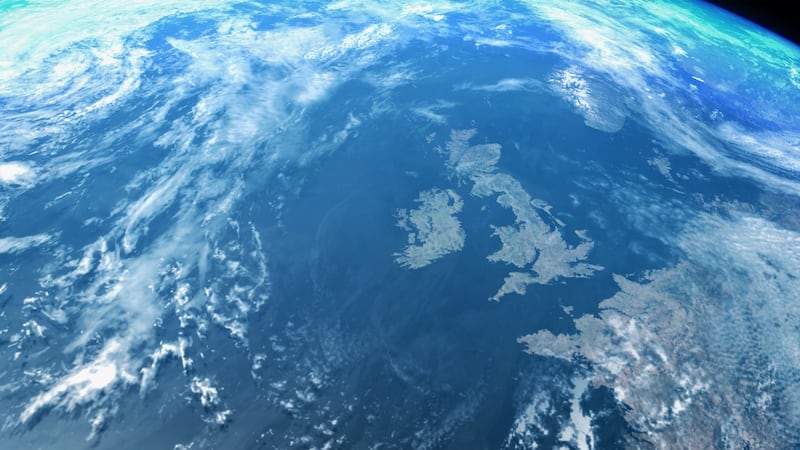Scientists have failed to persuade the world on the case for radical action to address a warming planet. With some despondency, weather forecaster Gerald Fleming notes he has been giving talks about climate disruption since the mid-1980s and yet global carbon emissions continue their relentless rise. Consequently, global temperatures mimic that trajectory, establishing new records almost on a monthly basis.
In the documentary Will Ireland Survive 2050? broadcast on RTÉ1 on Monday night, he scratches his head metaphorically at the public's complacency and climate "whataboutism" when it comes to reluctance to act in the face of certainty; more frequent extreme weather events that represent the biggest climate threat to the country over coming decades.
A combination of human testimonies and dramatic visuals – real and imagined, based on long-term weather projections – is the much different tack taken in contrast to cold, detached science.
The visceral signals; returning to repeatedly flooded homes, living beside raging gorse fires during a prolonged drought in Donegal, the sound of Greenland's melting ice cap, make the case more forcibly.
Visual representations of what extreme flooding might look like at landmark locations in our main cities, notably Dublin and Cork, are breathtakingly real. One, depicting a rigid inflatable boat making it way through floods enveloping the historic buildings of Trinity College, might seem outlandish.
Abandoning land and properties too costly to retain will in some instances be inevitable
Fleming with co-presenter Cara Augustenbourg, a UCD environmental researcher and climate activist, calmly outline how one-in-a-100 year events could become one-in-10 by mid-century. That does not add up to reckless hype.

The destabilising mix for Ireland is a combination of global warming caused by human activity; low atmospheric pressure; storm surges; unprecedented flooding; and sea-level rise projected to increase by up to 50cm come 2050 and directly attributable to the Arctic’s melting ice cap.
In this emerging physical world there are few winners and many hard choices. Abandoning land and properties too costly to retain will in some instances be inevitable. Development as a means of arresting the advance of the sea is presented, however, as a viable option.
It may appear astounding, but increased cold snaps are a real risk too as the Gulf Stream is in a state of flux due to global warming
So remarkably in Dublin's case it's "go east" by establishing a new neighbourhood in Sandymount and by developing the nearby Irish Glass Bottle site in Ringsend but at a height of 4 metres above ground. The only other option is an obtrusive four-metre high wall along the coastline to protect against weather extremes. So many flooding episodes in coming years will be a powerful persuader – unlike at present.

More cold snaps
It may appear astounding, but increased cold snaps are a real risk too as the Gulf Stream is in a state of flux due to global warming. "If the Gulf Stream changes, for Irish weather it's all change," Fleming remarks. If the ocean current disappears, it translates into 8 degrees of cooling. Dr Ger McCarthy of Maynooth University predicts "a 30 per cent slowdown by 2050".
The human consequences keep resurfacing; the carbon implications of our population rising by 2 million over the next 30 years; the likelihood that Ireland will become increasing attractive to migrants displaced by climate catastrophe or sea level rise – "that we become a lifeboat nation" as environmentalist Tara Shine describes it. The possibility of southern Spain being unlivable for heat-stressed people, where its traditional crops no longer survive, is not implausible in such circumstances.
The Midas Productions documentary directed by Martin Danneels is based on sound climate science, but ultimately an emotional argument is pushed on injecting more urgency in pursuing climate actions. In this case, adapting to ensure we become sufficiently resilient to withstand the inevitability of more frequent extreme weather events by 2050.

At its conclusion, the presenters and interviewees speak directly to the camera in spelling out their hopes and fears for 2050. Most will be old – Fleming notes he will be 93 – but actions are to ease inevitable trauma for their children and grandchildren based on current levels of unpreparedness.
He assures viewers we can change course, and adds, “For all our sakes, we should give it a right good go”. Austenbourg fears “we won’t act on time” to ensure a less risky future for her daughter.
But it is a man living beside Bertra Strand in Clew Bay, Co Mayo, which is already precariously surviving (just one big storm away from being enveloped by a warming Atlantic ocean), who best sums up the precarious scenario: "My hope is that the weather won't get any worse. My fear is it will."













